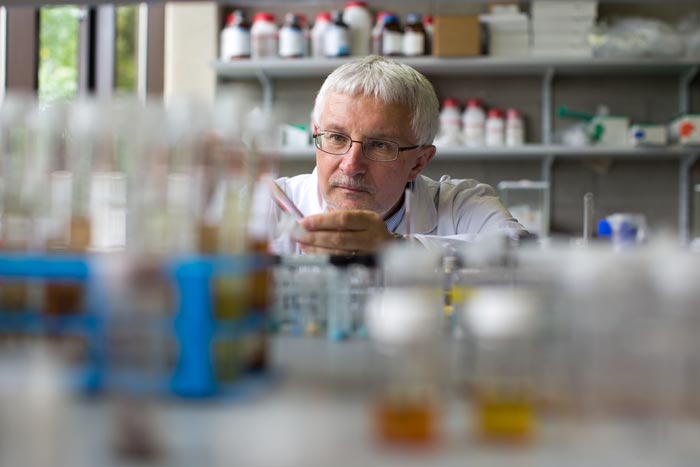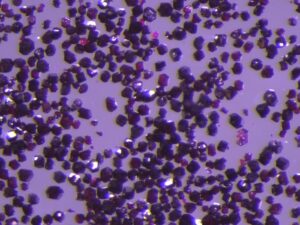New material can ‘capture toxic pollutants from air’

Professor Michael Zaworotko, Bernal Chair of Crystal Engineering and Science Foundation of Ireland Research Professor at University of Limerick’s Bernal Institute
Credit: True Media/Sean Curtin
New material is capable of capturing trace amounts of benzene, a toxic pollutant, from the air and crucially use less energy than existing materials to do so.
Researchers at University of Limerick, Ireland have developed a new material that has the ability to capture toxic chemicals from the air.

Credit: UL/Bernal
The material is capable of capturing trace amounts of benzene, a toxic pollutant, from the air and crucially use less energy than existing materials to do so, according to the researchers.
The sponge-like porous material could revolutionise the search for clean air and have a significant impact in the battle against climate change, the researchers believe.
Professor Michael Zaworotko, Bernal Chair of Crystal Engineering and Science Foundation of Ireland Research Professor at University of Limerick’s Bernal Institute, and colleagues developed the new material, with findings reported in the prestigious Nature Materials journal.
Volatile organic compounds (VOCs) including benzene are a class of toxic pollutants that cause severe environmental and health issues. Developing technologies to remove benzene from air at trace concentrations and doing it with a low energy footprint are both challenges that have not been overcome until now.
“A family of porous materials – like sponge – have been developed to capture benzene vapour from polluted air and produce a clean air stream for a long working time,” explained Professor Zaworotko.
“These materials could be regenerated easily under mild heating, making them candidates for air purification and environmental remediation.
“Our materials can do much better in both sensitivity and working time than traditional materials.”
Professor Zaworotko and Dr Xiang-Jing Kong from the Department of Chemical Sciences at UL, along with colleagues from leading universities in China, developed the new porous material which has such strong affinity for benzene that it captures the toxic chemical even when present at just 1 part in 100,000.
This material resembles Swiss cheese because it is full of holes and it is these holes that attract the benzene molecules, according to the researchers.
In terms of energy, because the capture process is based upon physical rather than chemical bonding, the energy footprint of capture and release is much lower than previous generations of materials.
“Breaking up gas mixtures is hard to do. This is especially true for the minor components that comprise air, which include carbon dioxide and water. The properties of our new material show that breaking up is no longer hard to do for benzene,” explained Professor Zaworotko.
Earlier work from Professor Zaworotko’s lab resulted in leading materials for carbon capture and water harvesting. The water harvesting material has such favourable properties for capturing and releasing water from the atmosphere that is already being used in dehumidification systems.
Dr Xiang-Jing Kong explained: “Based on smart design, our materials do well in addressing challenges of both technical and social relevance, such as trace benzene removal from air. This is hard for conventional materials, and thus highlights the charm of porous materials.”
Overall, these results suggest that a new generation of bespoke porous materials of the type invented at UL can enable a general approach to the capture of toxic chemicals from air.
“Aromatic isomers are difficult to separate in their mixtures with traditional methods, which are always energy-intensive,” Dr Xiang-Jing Kong explained.
“This research opened up possibilities to design porous materials for efficient separation of these chemicals with low energy input as well as removal of other trace pollutants from air.”
The study was funded by the European Research Council and Science Foundation Ireland.
The study, ‘Trace removal of benzene vapour using double-walled metal–dipyrazolate frameworks’ by Michael J. Zaworotko, Xiang-Jing Kong and others, is published in the journal Nature Materials. See here for more.
For further information, please contact:
Alan Owens
Communications Officer
University of Limerick
+353 87 908 6633
alan.owens@ul.ie
About University of Limerick:
The University of Limerick is a research-led, independent, internationally focused university with 17,500 students and 1,800 staff. It is a young, energetic and enterprising university with a proud record of innovation in education and excellence in research and scholarship.
More information is available at www.ul.ie.
Tweet @UL
Facebook.com/universityoflimerick
LinkedIn University of Limerick
Snapchat U of Limerick
About the Bernal Institute:
The Bernal Institute at University of Limerick is an €102-million science and engineering research institute comprising 20,000m2 of high-quality, multi-purpose research space in the new science and engineering zone at UL. The fluid fields of study and multidisciplinary nature of researchers working on structured materials uniquely enables the institute to address specific challenges within the areas of health, energy and the environment. The Bernal Institute is named after John Desmond Bernal, one of the most influential scientists of the 20th Century who was born in Nenagh, County Tipperary.
More information is available at www.bernalinstitute.com.
Tweet @BernalNews
LinkedIn Bernal Institute, University of Limerick
Journal: Nature Materials
DOI: 10.1038/s41563-022-01237-x
Method of Research: Meta-analysis
Subject of Research: Not applicable
Article Title: Trace removal of benzene vapour using double-walled metal–dipyrazolate frameworks
Article Publication Date: 28-Apr-2022
Media Contact
Alan Owens
University of Limerick
alan.owens@ul.ie
Office: 353-879-086-633
All latest news from the category: Materials Sciences
Materials management deals with the research, development, manufacturing and processing of raw and industrial materials. Key aspects here are biological and medical issues, which play an increasingly important role in this field.
innovations-report offers in-depth articles related to the development and application of materials and the structure and properties of new materials.
Newest articles

Innovative 3D printed scaffolds offer new hope for bone healing
Researchers at the Institute for Bioengineering of Catalonia have developed novel 3D printed PLA-CaP scaffolds that promote blood vessel formation, ensuring better healing and regeneration of bone tissue. Bone is…

The surprising role of gut infection in Alzheimer’s disease
ASU- and Banner Alzheimer’s Institute-led study implicates link between a common virus and the disease, which travels from the gut to the brain and may be a target for antiviral…

Molecular gardening: New enzymes discovered for protein modification pruning
How deubiquitinases USP53 and USP54 cleave long polyubiquitin chains and how the former is linked to liver disease in children. Deubiquitinases (DUBs) are enzymes used by cells to trim protein…



